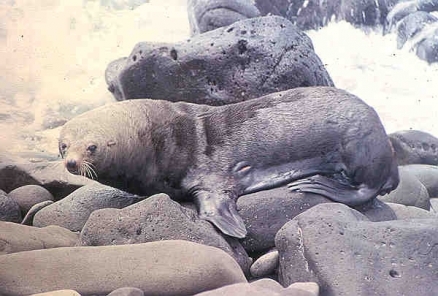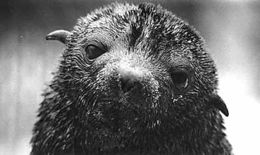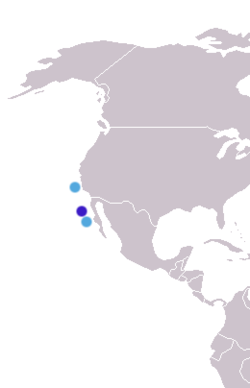Guadalupe fur seal
The Guadalupe fur seal (scientific name: Arctocephalus townsendi) is one of 16 species of marine mammals in the family of Eared seals which include sea lions and fur seals. Together with the families of true seals and Walruses, Eared seals form the group of marine mammals known as pinnipeds.
|
Conservation Status |
|
Scientific Classification Kingdom: Anamalia (Animals) |
| Common Names Foca Fina Lower californian fur seal |
The Guadalupe fur seal was long hunted for its dense, luxurious underfur and the species nearly driven to extinction. In 1892, only seven individuals were known to exist. Other than two males sold to the San Diego Zoo in 1928, only one other Guadalupe fur seal was sighted until 1954, when, remarkably, 14 individuals were discovered in 1954. Since then, the population has rebounded, but it remains the rarest of all fur seal species.
Eared seals differ from the true seals in having small external earflaps and hind flippers that can be turned to face forwards. Together with strong front flippers, this gives them extra mobility on land and an adult fur seal can move extremely fast across the beach if it has to. They also use their front flippers for swimming, whereas true seals use their hind flippers.
Like other Eared seals, the male Guadalupe fur seal is considerably larger than the female.
Contents
Physical Description
In males, the thick, dense coat is dark, greyish-brown to greyish-black. Much of the head and back of the neck may appear yellowish, and a silvery to yellowish-grey mane of long, coarse hair exists on the nape of the thick, muscular neck. Females are similarly coloured dark, greyish-brown to greyish-black, but often appear paler, creamy-grey on the underside of the neck and chest. Guadalupe fur seals have elongated, pointy snouts with whitish-cream whiskers, and the male has a large and bulbous nose.
The fur of Guadalupe fur seals is brownish gray dorsally, with a silvery and yellowish-gray "mane" on the nape of the neck. Their snouts are pointed, with a rust-orange color on the sides.
This species has great sexual dimorphism. Adult males usually weigh about 124 kg, and may get up to 160 kg, females weigh about 50 kg, rarely over 55. Males grow up to 1.9 m long, females to 1.4 m.
Reproduction
Like other fur seals, Guadalupe fur seals are territorial, with adult males fighting to form territories, and then endeavouring to accumulate females into their territories. Theyhave a polygynous breeding system, which involves a male seal with a territory (a bull) defending both his terriory and the females in his harem. The harem numbers between 4 to 12 females (average of 6.2), each of which typically have one pup.
Males will defend their territory for 35 to 122 days. Unlike most other seal species, the maleGuadalupe fur seals occasionally observe their harems from the water.
Female Guadalupe fur seals mate 7-10 days after giving birth to a pup conceived the previous year (post-partum estrus). Females lactate for an average of 9-11 months; how this related to the actual length of time before weaning is unclear.
Females start arriving at the breeding sites from mid-June to July or August, and give birth to a pup conceived the previous season within days of their arrival. About seven to ten days after giving birth the mother mates and then leaves to feed at sea. For the next eight to eleven months before the pup is weaned, the female will spend alternate periods of nine to thirteen days feeding at sea and nursing periods of five to six days back on land. Their search for prey may take them up to 500 kilometres away from their breeding sites and most of their dives are down to a depth of 50 metres. The Guadalupe fur seal diet is quite specialized on squid (95%) but also includes a few fishes.
Behavior
Mother seals use olfactory clues to find their pups after foraging trips.
The seals are not migratory, but a male and his females will occasionally diperse to new areas.
Distribution
The Guadalupe fur seal used to have a much wider distribution, but for most of the 20th century breeding was restricted to only one island; Isla de Guadalupe, off the coast of Baja California, Mexico. In 1997 a group of Guadalupe fur seals was observed in Islas San Benito, 165 miles south west of Isla Guadalupe. In 2006 and 2007 the first pups were seen in San Benito, and the species has spread out all around the San Benito Archipelago. Non-breeding seals range as far north as the Farallon Islands and Sonoma County, California, and south into the Gulf of California.
The Guadalupe fur seal is the only species of Arctocephalus found in the Northern Hemisphere.
Habitat
Guadalupe fur seals only live on rocky coasts and in the caves found along these shores. They can dive to an average maximum depth of 17m for an average of 2.5 minutes. When ashore, Guadalupe fur seals live and breed in rocky habitats, such as volcanic caves and grottos.
The Guadalupe fur seal plays the role of predator in the shoreline communities it inhabits.
Food Habits
Guadalupe fur seals eat a variety of fish, including lantern fish, mackerel, and fish in the muctophid family. Squid also constitute a major part of their diet. In all cases, the seals swim out to sea and dive for their prey items. During the breeding season, females make 2 to 6 day forging trips to sea, coming onshore in between each trip in order to suckle their pups.
Anchovy otoliths (bony concretions formed in the ears of fish) have been found the the digestive tracts of Guadalupe fur seals, but they are believed to be remains left from feeding of the seals by fishermen.
Conservation Status
In 1975, the Isla de Guadalupe was declared a sanctuary by the Mexican government and the Guadalupe fur seal is now fully protected under Mexican law. The species is also protected in the U.S. portion of its range by Californian law and is listed on Appendix I of CITES, prohibiting any international trade. Thankfully, these measures have produced a dramatic rise in numbers, and the future looks a little brighter for the world's rarest fur seal.
Prized for their luxurious underfur, Guadalupe seals were hunted to near extinction in the 19th century. Following its rediscovery in 1954, when just 14 individuals were found, the species has experienced a remarkable recovery.
Guadalupe Island was declared a seal sanctuary by the Mexican government in 1975. The Guadalupe fur seal was first placed on the "threatened" list in the US on March 11, 1967. By 1984 there were 1,600 seals in the Guadalupe Island population, including around 650 new pups.Population numbersreached a far healthier 7,348 by the early 1990s.
Despite the bottlenecks of the late 1800's, there still remains a high level of genetic variability in the population. The population of Guadalupe fur seals is growing at the rate of 11.5% per annum.
Nevertheless, some Guadalupe seals may still be killed through entanglement in drift and set gillnets and individuals, particularly juvenile females, have been found stranded with injuries caused by entanglement in marine debris. In addition, El Nino and Hurricane Darby were responsible for 33 percent pup mortality in 1992, but it is not known how the population was affected by the 1997 to 1998 El Nino event.
Economic Importance for Humans
Prehistorically, Guadalupe fur seals may have been hunted by Chumash Indians at San Miguel Island and other Channel Islands in California. The seal produces a rich, dense fur that was highly prized up until recent times, with the species nearly driven to extinction by seal hunters in the 1880's. In 1892, only seven individuals were known to exist. The population has rebounded, and the trade in the fur of Guadalupe fur seals is prohibited.
Further Reading
- Arctocephalus townsendi Encyclopedia of Life (accessed April 5, 2009)
- Arctocephalus townsendi, Nabong, M., 2002, Animal Diversity Web (accessed April 5, 2009)
- Guadalupe Fur Seal, Seal Conservation Society (accessed April 5, 2009)
- The Pinnipeds: Seals, Sea Lions, and Walruses, Marianne Riedman, University of California Press, 1991 ISBN: 0520064984
- Encyclopedia of Marine Mammals, Bernd Wursig, Academic Press, 2002 ISBN: 0125513402
- Marine Mammal Research: Conservation beyond Crisis, edited by John E. Reynolds III, William F. Perrin, Randall R. Reeves, Suzanne Montgomery and Timothy J. Ragen, Johns Hopkins University Press, 2005 ISBN: 0801882559
- Walker's Mammals of the World, Ronald M. Nowak, Johns Hopkins University Press, 1999 ISBN: 0801857899
- Guadalupe Fur Seal, MarineBio.org (accessed April 5, 2009)



